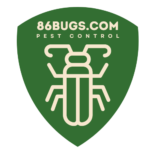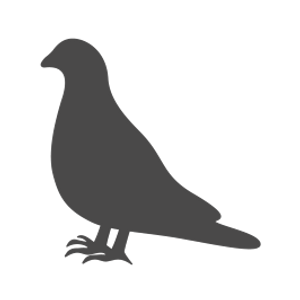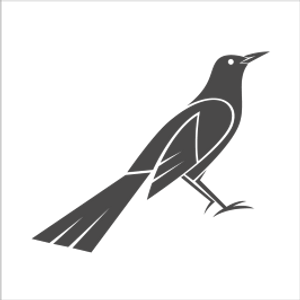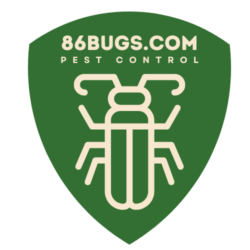Avian Nuisance Mitigation
Swallows
Keep Barn Swallows and Mud Swallow birds from building mud nests on your property with 86Bugs line of swallow deterrents. Affordable, effective, humane and easy to install.
Barn Swallow birds and or Mud Swallows migrate from North American breeding grounds to winter sites in Central and South America. Southbound fall migration can start in late June in Florida or early July in Massachusetts. The birds return as early as late January in southern California to mid-May at Alaskan breeding sites. They build mud nests in eaves and overhangs. As a highly protected bird, property owners are encouraged to take proactive steps to prevent them from settling in and building nests, which can be both unsightly and damaging.
Important: Swallows are protected under the Federal Migratory Bird Act which states that once an egg is laid in a nest, the nest is to remain intact until the hatchlings have left. Avoid hefty fines, call 86Bugs at for advice or an installer in your area.
Information About Swallows
Barn swallows and Mud Swallows typically have a red face, an upper part body covered in blue feathers and a white bottom. They are about 6.5 inches long, weigh just over half an ounce and eat mainly insects. Swallows can be found in fields, meadows and rural areas, often choosing habitats near the water. They will build semicircular nests under eaves, barns, stables, buildings and bridges.
Physical Characteristics
Swallows are small to medium-sized passerines with slender bodies, long, pointed wings, and distinctive forked tails. Their streamlined bodies are adapted for efficient flight, allowing them to glide and swoop with agility. Most species exhibit a metallic sheen on their feathers, which can appear in various hues of blue, green, or purple, depending on the species and light conditions. The common barn swallow (Hirundo rustica), for example, has a glossy blue back, reddish-brown throat, and a pale underbelly.

Barn Swallows Birds Behavior and Diet
Swallows are highly social birds, often seen in flocks, especially outside the breeding season. Their flight is characterized by swift, acrobatic maneuvers, which they use to catch insects mid-air. This diet primarily consists of flying insects such as flies, beetles, and moths, making them beneficial for controlling insect populations. Swallows have a unique feeding behavior; they skim close to the water or ground to catch their prey, an action facilitated by their broad, open mouths.

Migration Patterns Of Swallows
One of the most extraordinary aspects of swallow behavior is their long-distance migration. Swallows are among the most accomplished migrants, with some species traveling thousands of miles between their breeding and wintering grounds. The Barn Swallow, for example, breeds across North America, Europe, and Asia, and migrates to Central and South America, Africa, and southern Asia for the winter. These migrations are triggered by changes in daylight length and temperature, and are essential for avoiding the cold, insect-scarce winters of their breeding grounds.

Habitat and Nesting
Swallows are versatile in their habitat preferences, found across various environments including open fields, farmlands, and near bodies of water. They are particularly drawn to areas with abundant insect life and suitable nesting sites. Swallows are known for their mud-built nests, which they often construct under eaves, bridges, or inside barns and sheds. These nests are typically cup-shaped structures made from mud pellets and lined with feathers and soft materials. Swallows exhibit strong site fidelity, often returning to the same nesting sites year after year.

Why Swallow Bird Control?
Swallows will leave walls, eaves and fences covered with unappealing mud nests. The nests are not only unattractive, but they can permanently damage the surfaces onto which they are built. Swallow bird nests and droppings may also breed bacteria, fungal agents and parasites, which contain such serious diseases as histoplasmosis, encephalitis, salmonella, meningitis, toxoplasmosis and more. Swallows are protected by the Migratory Bird Treaty Act of 1918, so it’s illegal to intentionally capture, kill or disrupt these migratory birds or their nests and eggs.
How to Get Rid of Swallows
The best way to get rid of swallows is to be proactive and discourage them from building nests in the first place. There are several humane options for deterring swallows from landing or nesting on your property. Here are a few steps you can take to get rid of swallows:
DIY Home Swallow Bird Control Solutions:
Pairing the following two swallow control products together will result in higher success rates:
- Swallow Shield is designed to humanely stop swallows form building mud nests along your home. Each pack included two 3” x 11” strips equipped with clear monofilament to deter swallows. Swallow Shield pairs incredibly well with Bird-Out to prevent swallow infestations.
- Bird-Out Kit is an aromatic swallow repellent kit designed for outdoor areas with homeowners in mind. The small discrete dispenser installs in minutes and cartridges are replaced in seconds. Each cartridge contains a 20% concentrate of Methyl Anthranilate, a grape seed extract proven to repel birds. While Swallow Shield strips block mud nests from forming, Bird-Out repels swallows from the surrounding 20’ x 20’ x 20’ area with a pleasant grape aroma.
Professional Swallow Control:
The following two options are the most common solutions used by bird control professionals:
- 3/4" Bird Netting is the standard size mesh installed to exclude swallows from building mud nests. When installed correctly, bird netting will physically prevent nests from forming under eaves and other common areas.
- Bird Slopes can be used to create an additional barrier between the swallow and a desired nesting spot. Slope is available in gray and stone colors to match existing sidewalls.
Remove Food Sources
- Swallows may be attracted to your garden, lawn area or song bird feeders as a food source. Remove feeders to limit this attraction.
- Remove leftover food on the ground and tables of open-air eateries. Tightly close all trash containers.
- Discourage the feeding of swallows by children or employees.
Bird Control Scare Tactics
Swallows are quick and alert to any perceived threats, so scare tactics can be highly effective.
- Sound deterrents such as the Bird Chase Super Sonic noise machine play swallow distress calls, letting swallows know the area is not safe to nest in.
- Create a visual distraction zone by hanging Visual Deterrents, such as flash tape, Predator Eye Balloon and Reflective Eye Diverters.















